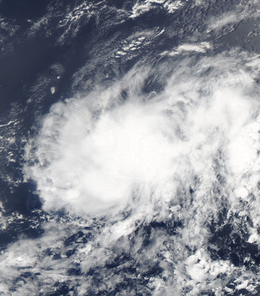Tropical Depression Ten (2005)
| Tropical Depression (SSHWS/NWS) | |
 Tropical Depression 10 | |
| Formed | August 13, 2005 |
|---|---|
| Dissipated | August 14, 2005 |
| Highest winds | 1-minute sustained: 35 mph (55 km/h) |
| Lowest pressure | 1008 mbar (hPa); 29.77 inHg |
| Fatalities | None reported |
| Damage | None |
| Areas affected | None |
| Part of the 2005 Atlantic hurricane season | |
Tropical Depression Ten was the tenth tropical cyclone of the 2005 Atlantic hurricane season. The depression formed on August 13 from a tropical wave that entered the Atlantic Ocean on August 8. Because of strong wind shear, the depression stayed weak and did not strengthen much. The cyclone itself had no effect on land and did not cause any damage. It mostly died out on August 14, but its remains later helped to form another storm, Hurricane Katrina. Katrina became one of the worst hurricanes in the history of the United States.[1][2][notes 1]
Storm history
The tropical depression began as a tropical wave that entered the Atlantic Ocean on August 8, 2005. The wave moved west. It began to show signs of becoming stronger on August 11. The system formed into Tropical Depression Ten at 1200 UTC on August 13. At the time, it was about 1,600 miles (2,600 km) to the east of Barbados.[3] When the storm was first called a tropical depression, it had a large area of thunderstorms, with curved rainbands.[4]

The depression slowly moved west, and wind shear stopped the storm from becoming much stronger. Late on August 13, a weather forecaster said that it was "beginning to look like Irene-junior". They said this because it was mid-level shear happening in the storm towards the southwest "beneath the otherwise favorable upper-level outflow pattern".[5] This means that the storm looked similar to Hurricane Irene.
Early on August 14, the wind shear tore apart the storm. The center of the storm separated from the thunderstorm areas.[6] Later that day, the cyclone became even weaker. The National Hurricane Center gave their final warning on Tropical Depression Ten, and the storm mostly disappeared. However, its remains produced a few bursts of thunderstorm activity for several days, before completely stopping on August 18.[3]
Energy left over from Tropical Depression Ten helped to form Tropical Depression Twelve over the southeastern Bahamas on August 23.[7][8] Normally, if a depression disappears and forms again, it keeps the same number. However, the formation of Tropical Depression Twelve involved other weather systems, including another tropical wave.[9] Tropical Depression Twelve later became Hurricane Katrina.[1]
Impact
Tropical Depression Ten did not hit land. Because of this, no tropical cyclone watches and warnings were given out. It did not damage anything or cause any people's deaths, and no ships reported strong winds. Also the depression never became a tropical storm, so it was not given a name by the National Hurricane Center.[3]
After the depression mostly died, part of its remains helped to form Hurricane Katrina. Katrina later became a Category 5 hurricane and made landfall in Louisiana, where it caused very bad damage. It was one of the worst hurricanes in the history of the United States.[1]
Other pages
Notes
- ↑ It caused the most damage in terms of money and killed 1,836 people in the United States, and is thus considered one of the worst hurricanes.
References
- ↑ 1.0 1.1 1.2 Knabb, Richard D (2005-12-20; updated 2006-08-10). "Tropical Cyclone Report: Hurricane Katrina: 23–30 August 2005" (PDF). National Hurricane Center. Retrieved 2009-08-10.
{{cite web}}: Check date values in:|date=(help); Unknown parameter|coauthors=ignored (|author=suggested) (help) - ↑ "Reports of Missing and Deceased". Louisiana Department of Health and Hospitals. 2006-08-02. Retrieved 2010-04-14.
- ↑ 3.0 3.1 3.2 Jack Beven (2006-01-17). "Tropical Depression Ten Tropical Cyclone Report" (PDF). National Hurricane Center. Retrieved 2009-08-10.
- ↑ Avila (2005-08-15). "Tropical Depression Ten Discussion Number 1". National Hurricane Center. Retrieved 2009-01-21.
- ↑ Stewart (2005-08-13). "Tropical Depression Ten Discussion Number 2". National Hurricane Center. Retrieved 2008-01-21.
- ↑ Knabb (2005-08-14). "Tropical Depression Ten Discussion Number 3". Retrieved 2009-01-21.
{{cite web}}: Text "publisherNational Hurricane Center" ignored (help) - ↑ United States Senate (2006). Hurricane Katrina: a nation still unprepared. U.S. Government Printing Office. p. 61. ISBN 0160767490.
- ↑ Michael P. Erb. "A Case Study of Hurricane Katrina: Rapid Intensification in the Gulf of Mexico" (PDF). University of North Carolina. Retrieved 2009-06-26.
- ↑ Stewart, Stacy (2005-08-13). "Tropical Depression Twelve Discussion Number 1". National Hurricane Center. Retrieved 2009-01-21.
